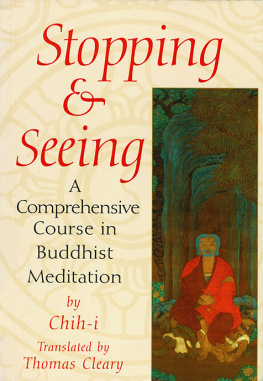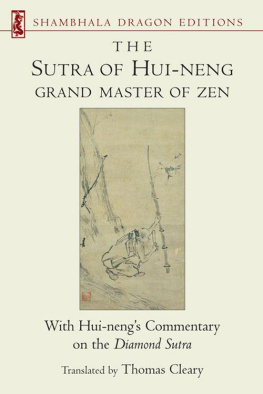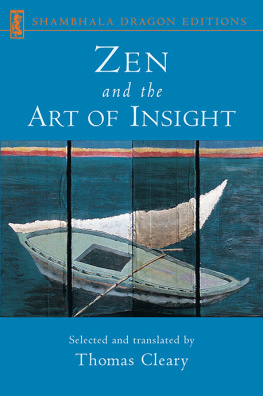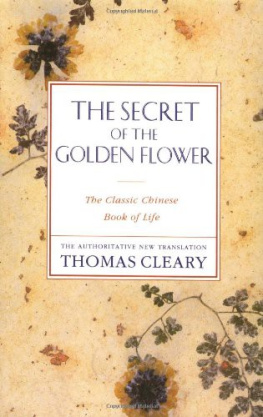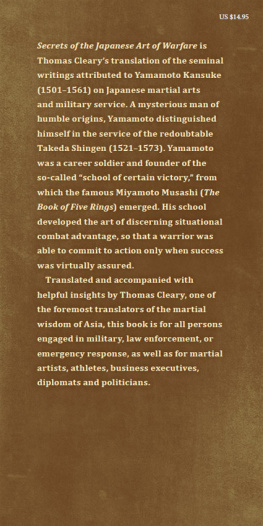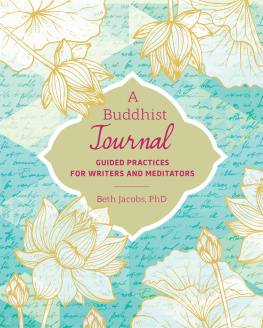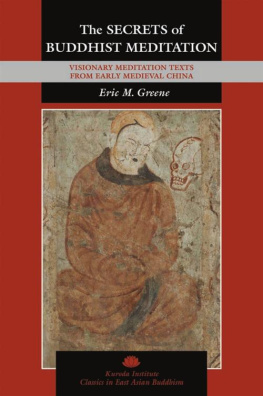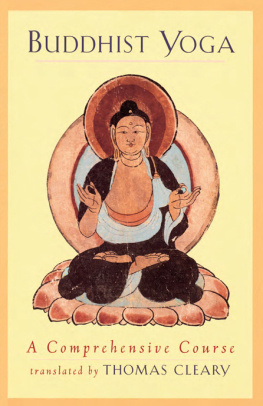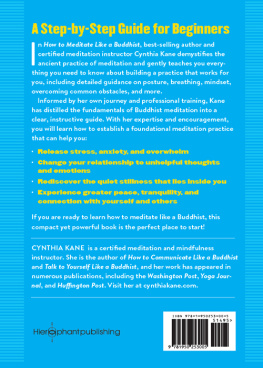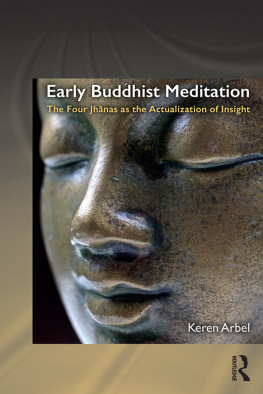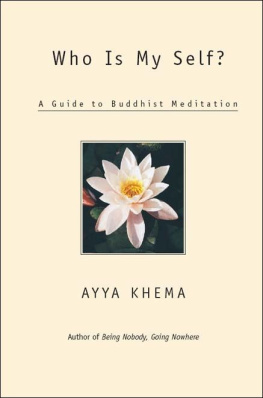ABOUT THE BOOK
Stopping and seeing are sometimes referred to as the yin and yang of Buddhist meditationcomplementary twin halves of a unified whole. In essence, stopping and seeing refers to stopping delusion and seeing truth, processes back to basic Buddhist practice. One of the most comprehensive manuals written on these two essential points of Buddhist meditation is The Great Stopping and Seeing, a monumental work written by sixth-century Buddhist master Chih-i. Stopping and Seeing, the first translation of this essential text, covers the principles and methods of a wide variety of Buddhist meditation techniques and provides an in-depth presentation of the dynamics of these practices.
THOMAS CLEARY holds a PhD in East Asian Languages and Civilizations from Harvard University and a JD from the University of California, Berkeley, Boalt Hall School of Law. He is the translator of over fifty volumes of Buddhist, Taoist, Confucian, and Islamic texts from Sanskrit, Chinese, Japanese, Pali, and Arabic.
Sign up to learn more about our books and receive special offers from Shambhala Publications.

Or visit us online to sign up at shambhala.com/eshambhala.
STOPPING AND SEEING
A COMPREHENSIVE COURSE IN BUDDHIST MEDITATION
Chih-i
TRANSLATED BY
THOMAS CLEARY

SHAMBHALA
Boston & London
2014
SHAMBHALA PUBLICATIONS, INC.
HORTICULTURAL HALL
300 MASSACHUSETTS AVENUE
BOSTON, MASSACHUSETTS 02115
www.shambhala.com
1997 by Thomas Cleary
All rights reserved. No part of this book may be reproduced in any form or by any means, electronic or mechanical, including photocopying, recording, or by any information storage and retrieval system, without permission in writing from the publisher.
Library of Congress Cataloging-in-Publication Data
Chih-i, 538597.
[Mo ho chih kuan. English. Selections]
Stopping and seeing: a comprehensive course in Buddhist meditation/Chih-i; translated by Thomas Cleary.
p. cm.
eISBN 978-0-8348-2939-8
ISBN 1-57062-275-2 (alk. paper)
1. Tien-tai BuddhismDoctrinesEarly works to 1800. 2. MeditationxTien-ttai BuddhismEarly works to 1800. 3. Samatha (Buddhism)Early works to 1800. 4. Vipasyan (Buddhism)Early works to 1800. I. Title.
BQ9149.C454M6213 1997
CONTENTS
STOPPING AND SEEING ARE THE YIN AND YANG of Buddhist meditation, complementary twin halves of a unified whole. The fundamental meaning of stopping and seeing, sometimes more solemnly called cessation and contemplation, is stopping delusion and seeing truth. All Buddhist meditations, and indeed all Buddhist principles and practices, can be categorized and organized in terms of stopping, seeing, and the integration of stopping and seeing.
There are a number of books on stopping and seeing written in Chinese. The most comprehensive of these is called Mo-ho Chih-kuan, or Great Stopping and Seeing, a record of lectures on Buddhist meditation by the great Tien-tai master Chih-i, who lived in the sixth century.
Great Stopping and Seeing is one of the so-called Three Great Works of Tien-tai Buddhism, which all apprentices of that school educated in the traditional manner are expected to work through in the course of a twelve-year period of learning and practice.
Great Stopping and Seeing is also a traditional source-book for Zen and Pure Land Buddhism. Both Zen and Pure Land Buddhism were intimately connected with Tien-tai Buddhism in their early stages of development, and contact was renewed at various points in history, not only in China but also in Korea and Japan. The Tien-tai patriarch Chih-i appears as a Zen master in Zen literature, and as a Pure Land patriarch in Pure Land literature.
Chih-i lived from 538 to 597 of the common era. His father, whose surname was Chen, was from an old family of Confucian scholars, distinguished in public service for generations. His mother was from the Hsu clan, which was deeply involved in Taoism and produced many distinguished figures in that discipline. The inclusion of Taoist medical doctrines and practices in Chih-is work on Buddhist meditation probably reflects his early education within the family context.
Chih-i was inspired as a child by hearing recitation of Buddhist scripture, which seemed inexplicably familiar to him. When he was fifteen years old, he determined to enter religious orders, leaving behind the political or military career Confucian men of leading families were ordinarily expected to pursue. His parents would not permit his ordination, and he formally became a Buddhist novice only after they passed away when he was eighteen years old.
Fully ordained at the age of twenty after a two-year novitiate, Chih-i spent the next twenty years reciting scriptures and studying the whole Buddhist canon. He also practiced repentance rituals, which are supposed to purify the mind of stultifying accretions and adhesions of mundane habit. Rewarded for his efforts with beatific visions as depicted in the scriptures, Chih-i was now constantly rapt in meditation.
Satisfied for a time with his experiences, Chih-i no longer felt the need to seek advice from anyone. This changed when the meditation master Hui-ssu (514577) appeared.
It is said that Hui-ssu had foreseen the persecution of Buddhism that was to take place in northern China in the 570s and was heading for the sacred Mount Heng, the southern of the five sacred mountains of traditional China. He and Chih-i met on a mountain in what is now Hunan, where Hui-ssu had stopped on his way.
Completing his studies under the guidance of Hui-ssu, Chih-i took his leave in 569 and went to Chin-ling (present-day Nanking), where he began to teach. In 575 he left his followers, for unspecified reasons, and went into seclusion on Mount Tien-tai, Terrace of Heaven, located in Chekiang province on the eastern seaboard of China. There Emperor Hsuan of the Chen dynasty, who was a clansman of the master, had a monastery built for him, assigning the tax revenues of a considerable area to its upkeep. It is from this mountain that the Tien-tai school gets its name.
The Chen dynasty was destroyed in 588 by the Sui dynasty, under which China was reunified after centuries of division into Turkic and Chinese empires. Imperial patronage of Chih-i and his Tien-tai school continued, nevertheless. The first emperor of the new dynasty, a devotee of Buddhism, requested and received the bodhisattva precepts and a religious name from Chih-i, and in turn bestowed on the teacher an honorific title, Chihche, the Wise One, by which he is also commonly known. Chih-i spent the rest of his life teaching on Mount Tien-tai, and his lectures, recorded and compiled by his foremost disciple, became one of the most important resources of East Asian Buddhism.
The vast quantity and range of Indian and Central Asian Buddhist literature translated into Chinese, originating from different communities and formulated at different times, confronted the Chinese Buddhists with the monumental problem of organizing, systematizing, and synthesizing this material. Each of the major schools of Chinese Buddhism developed its own method of classifying the teachings, and the Tien-tai school of Chih-i features one of the most elaborate schemes of theoretical and practical syncretism, based on the times, methods, and levels of meaning of the various doctrines.
For the purposes of stopping and seeing, Chih-is classification of Buddhist teachings centers on four levels of doctrine, referred to as the Three Baskets teaching, the common teaching, the separate teaching, and the complete teaching. The Three Baskets teaching refers to what is often called the Hinayana or Small Vehicle, which focuses on individual liberation. The common teaching refers to the doctrine of emptiness, which pervades all the teachings, although it is implicit in some and explicit in others. The separate teaching is so called because it is special in that it is only for greathearted bodhisattvas, who work for the welfare, liberation, and enlightenment of all beings. The complete teaching deals with universal Buddha-nature and the attainment of all knowledge.
Next page
